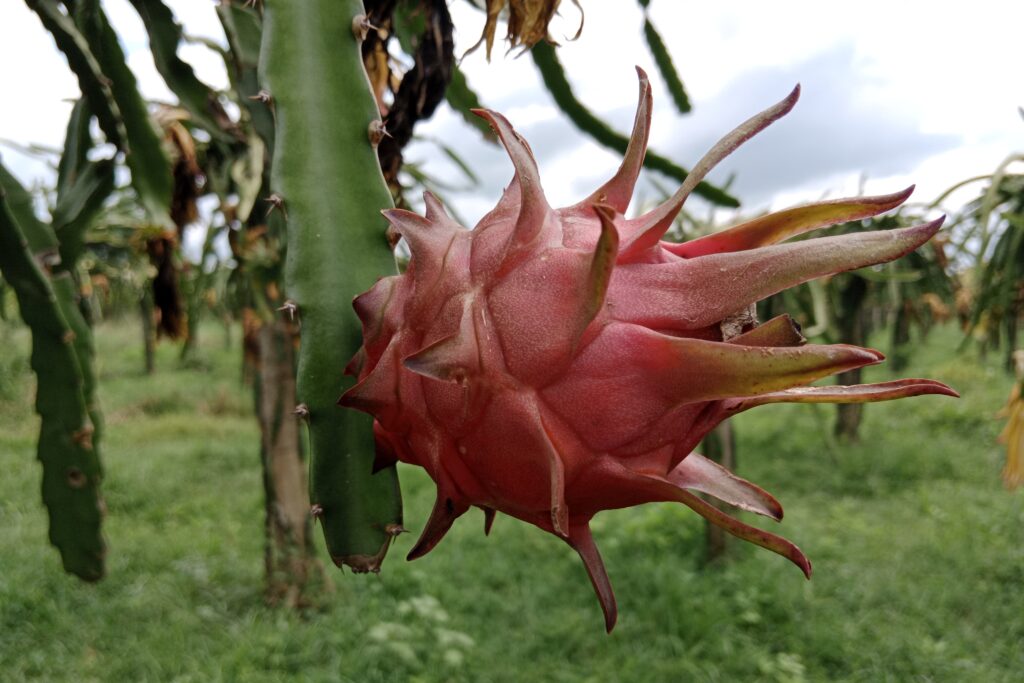Jujube Farming (Apple Ber)
Ber (Indian Jujube – Ziziphus mauritiana) farming represents a highly profitable long-term agricultural investment, particularly when evaluated on a per-acre basis. With a moderate initial setup cost of approximately NRs. 139,000 per acre covering land preparation, saplings, planting, and infrastructure, and a manageable annual maintenance expense of NRs. 75,000 from the second year onward, this orchard model delivers exceptional returns.
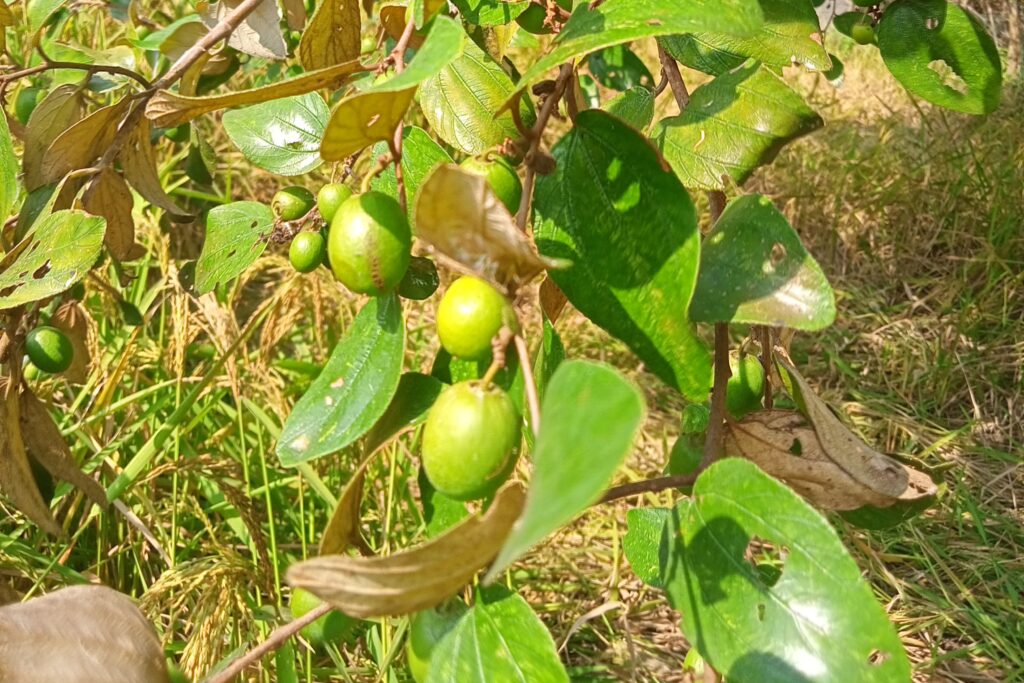
The Jujube farming profit per acre escalates dramatically as trees mature, with farmers achieving a cumulative net profit exceeding NRs. 2.5 million over a 15-year cycle. Economically viable yields begin in the 3rd year, but peak profitability is sustained from the 5th year through Year 15, driven by robust annual harvests of 11,200 kg/acre sold at a conservative market price of NRs. 30/kg.
This combination of resilient crop performance, rising market demand, and scalable cultivation practices solidifies jujube as a strategic high-return venture for agri-entrepreneurs.”
Land Preparation
Land preparation for apple ber farming begins with clearing the land of existing vegetation, rocks, and debris, followed by deep plowing to a depth of 30–45 cm using a moldboard plow or disc harrow to break compacted soil and enhance aeration and drainage.
This is followed by 2–3 cross harrowings to achieve a fine tilth and create a crumbly soil structure. The field should be leveled properly to ensure uniform water distribution during irrigation, and bunds and drainage channels must be established, especially in regions with heavy rainfall or poor natural drainage.
Soil Type
Because Ber can be grown on so many different types of soil, it can be planted on shallow and deep soils, gravelly, sandy, and clay soils, as well as marginal locations that are often considered unsuitable for cultivation. It can withstand weakly saline and alkaline conditions, and it can even survive mild waterlogging to some extent.
It thrives, however, on deep, sandy loam to loamy soils that drain well and have enough moisture retention and aeration for optimal development and yield. Despite its ability to tolerate a wide pH range of 5.5 to 8.5, it should not be applied to heavy clay soils that are susceptible to waterlogging or to very shallow or gravelly soils with low water-holding capacities.
Climatic Requirements
Jujube thrives in regions with hot summers—tolerating temperatures up to 48°C during fruit development—and cool, dry winters with temperatures dropping as low as 0°C during dormancy, though frost during flowering can harm blooms.
Temperature fluctuations during the ripening phase help enhance fruit sweetness. It performs best in areas with low to moderate annual rainfall (300–500 mm), as excessive humidity and rain during flowering and fruiting increase the risk of pests and diseases. Dry weather is essential during ripening, and full sunlight is necessary for optimal plant growth, flowering, and fruit quality.
Major Cultivars
The selection of Ber varieties depends on factors such as local climate conditions, market preferences, and the intended use of the fruit, whether for fresh consumption or processing.
| Cultivar | Shape & Size | Flavor & Texture | Key Characteristics & Uses | Yield / Special Notes |
| Gola | Large, Round | Crisp, Juicy, Sweet | Excellent quality. High yield. | Most popular variety. |
| Seb | Large, Oblong (Apple-shaped) | Crisp, Juicy, Sweet-Acid | Good life. Vigorous grower. | |
| Umran | Large, Elongated | Sweet, Firm | Excellent for fresh consumption & processing. Heavy bearer. | |
| Kaithli | Medium-Large, Roundish | Sweet | Good quality. Early maturing. | |
| Sanaur-2 | Medium, Round | Sweet | Good yield potential. | |
| Sanaur-5 | Large, Oblong | Crisp, Sweet | Suitable for arid regions. | |
| ZG 2 | Medium, Oblong | Sweet | Bright green when ripe. Resistant to powdery mildew. Spreading tree type. | Ready by March-end. Avg. yield: 150 kg/tree. |
| Wallaiti | Medium-Large, Oval | Soft pulp | Golden yellow when ripe. TSS: 13.8-15%. | Avg. yield: 114 kg/tree. |
Seedling rate per acre
Ber is propagated vegetatively through methods such as budding or grafting, and a planting density of approximately 112 plants per acre is typically maintained for optimal growth and productivity.
Planting
Planting Season
The ideal planting season for Ber is during the monsoon months of July to August in most regions, taking advantage of natural rainfall. However, planting can also be successfully carried out in early spring, between February and March, provided there is assured irrigation to support initial establishment.
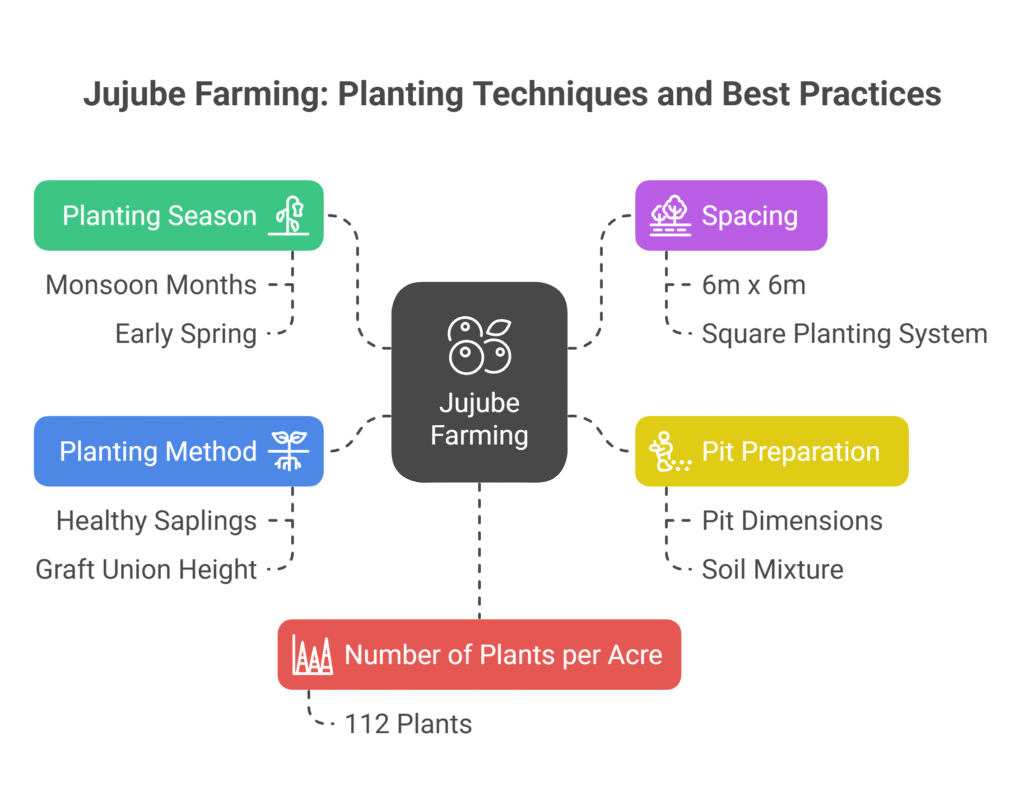
Spacing
The standard spacing for planting Ber trees is 6m x 6m in a square planting system, allowing sufficient space for healthy growth and canopy development.
Pit Preparation
Pits measuring 1m × 1m × 1m (length, width, and depth) should be dug well in advance—ideally 1 to 2 months before planting—with topsoil and subsoil kept separate. Each pit is then filled slightly above ground level with a mixture of topsoil combined with 25–30 kg of well-rotted Farm Yard Manure (FYM) or compost, 1 kg of Single Super Phosphate (SSP), 100 g of neem cake, and optionally 50 g of Lindane dust to control termites, allowing the mixture to settle before planting
Planting Method
When planting Ber, choose healthy, certified grafted or budded saplings from reputable nurseries that are between 6 and 12 months old. After making a tiny hole in the middle of the pit, carefully plant the sapling, making sure the graft union is at least 10 to 15 cm above the ground.
To ensure stability, carefully press the soil around the roots; water the plant well straight away after planting; and, if required, use a support post to keep the young tree upright during establishing.
Number of Plants per Acre
A typical Ber orchard accommodates approximately 112 plants per acre.
Intercropping
Intercropping is highly recommended during the first 3–4 years of Ber cultivation before the tree canopy closes, using short-duration, shallow-rooted, non-climbing, and low-nutrient competing crops such as legumes (moong, moth, cowpea), vegetables (tomato, brinjal, cucumber), and spices (coriander, fennel).
It is important to avoid tall, nutrient-demanding, or densely planted crops like sugarcane, maize, and turmeric. Intercrops should be provided with separate irrigation and fertilization, and a clean basin with a radius of 1 to 1.5 meters should be maintained around young Ber trees to prevent competition and ensure healthy growth.
Irrigation
Irrigation is critical for Ber at key stages such as after planting, during the summer months of May and June, at flowering between October and November, and throughout fruit development from December to February. Young plants aged 1 to 3 years require frequent watering every 7–10 days in summer and every 15–20 days in winter to ensure proper establishment.
Mature plants over 4 years old are drought-tolerant but benefit from irrigation every 15–20 days during summer and fruit development. Irrigation should be withheld 2–3 weeks before flowering to induce dormancy and stress, which promotes synchronized flowering, then resumed after flower buds initiate.
Common irrigation methods include basin and ring irrigation, with drip irrigation being the most efficient as it conserves water, reduces weed growth, and allows for fertigation, while avoiding waterlogging is essential.
Fertilizer and Manure
For accurate fertilizer application, always follow the recommendations provided in the soil test report.
Fertilizer requirements for Ber trees depend on the age of the crop. For a one-year-old tree, apply 20 kg of well-decomposed cow dung along with 100 g of nitrogen (N), 50 g of phosphorus (P₂O₅), and 50 g of potassium (K₂O) per tree annually.
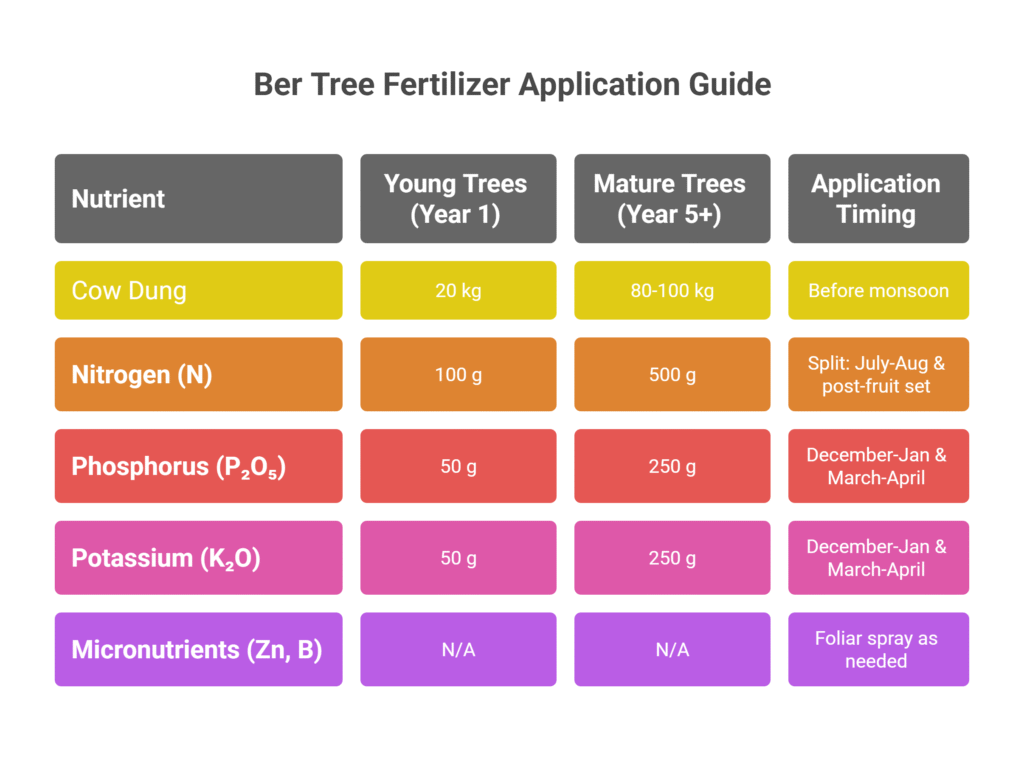
As the tree matures, increase the fertilizer dose by approximately 50% each year. By the fifth year and beyond, each tree should receive 80–100 kg of cow dung, 500 g of nitrogen, 250 g of phosphorus, and 250 g of potassium annually for optimal growth and yield.
Apply the full amount of cow dung before the onset of the monsoon. Nitrogen (urea) should be split into two equal applications: the first in July–August and the second after the fruit set stage to support healthy fruit development.
For nitrogen and potassium, split the annual dose into two halves—one applied as a basal dose in December–January and the other in March–April. This timing ensures nutrient availability throughout critical growth stages.
Manure and compost should be spread evenly around the tree basin under the drip line and lightly incorporated into the soil. Fertilizers should be applied in 10–15 cm deep circular trenches along the drip line and then covered with soil to prevent loss.
Micronutrient deficiencies, such as zinc and boron, may be addressed through foliar sprays—using 0.5% zinc sulfate (ZnSO₄) and 0.1–0.2% borax—especially if symptoms like little leaf appear.
Weed Control
Keeping the tree basin (1–2 meters in diameter) weed-free throughout the year is essential for healthy Ber growth. Weeds can be managed mechanically through regular shallow hoeing or hand weeding, taking care not to damage the roots.
Mulching is highly effective and strongly recommended. Apply an 8–10 cm thick layer of organic mulch—such as paddy straw, dried grass, or sugarcane trash—around the base of each tree. Mulching helps conserve soil moisture, suppresses weed growth, moderates soil temperature, and enhances soil fertility as it decomposes.
Chemical weed control should only be used when necessary and under expert supervision. Pre-emergence herbicides like Diuron at 400 g active ingredient per acre can be used. For post-emergence control, Glyphosate (800–1000 ml per acre) may be applied as a directed spray with extreme caution to avoid contact with the tree trunk or foliage. Despite the availability of herbicides, mulching remains the safer and more sustainable weed
Interculture Operation
Training (Initial 2-3 years)
During the first 2–3 years, training is essential to develop a strong and well-balanced framework. Aim to establish 3–4 well-spaced primary branches emerging at a height of 60–75 cm from the ground. Regularly remove unwanted shoots, suckers, and inward-growing branches to maintain proper canopy structure and airflow.
Pruning (Annual)
Annual pruning is crucial for Apple Ber and should be carried out after harvest, typically between December and February, before new growth begins. The process involves removing dead, diseased, damaged, weak, and criss-crossing branches, thinning out overcrowded fruiting wood, and heading back excessively long shoots to encourage branching.
Water sprouts and suckers should also be removed to maintain a healthy canopy. An open-center structure should be maintained to ensure adequate light penetration and air circulation. In the case of old or neglected trees, rejuvenation pruning—severely cutting back main branches—can be done to stimulate fresh, productive growth.
Flowering and Fruit Management
Flowering
Flowering Apple Ber flowers emerge from the leaf axils in clusters called cymes during the current growing season. The specific period of flowering may vary based on the area and cultivar, although it usually happens between October and November. Dry weather is necessary for flowering to occur successfully, and flies and honeybees are the main pollinators.
Fruit Set and Drop
Natural fruit drop in Ber is a common phenomenon and happens in stages. An initial heavy drop soon after flowering is considered normal. A secondary drop often occurs 4–6 weeks after fruit set, primarily due to competition among developing fruits for nutrients and water. While some fruit drop is natural, excessive drop can affect final yields.
Fruit Thinning
Fruit thinning is especially important in Apple Ber cultivars to ensure high-quality produce. It is typically done 6–8 weeks after fruit set when the fruits are about the size of peas. During thinning, only 1–2 healthy fruits per cluster should be retained, spaced about 5–7 cm apart.
This process involves removing misshapen, diseased, or overcrowded fruits using secateurs or by gently twisting them off. Proper thinning enhances fruit size, quality, and uniformity, reduces pest and disease pressure, and prevents branches from breaking due to excessive fruit load.
Pest and Disease Management
Common Pests
Fruit Fly (Bactrocera spp.)
The most damaging insect in Ber is the fruit fly, which damages developing fruits by depositing eggs inside them, causing internal rotting and early fruit drop. Regular sanitation through the collection and destruction of fallen and infected fruits is a component of effective management.
To keep an eye on and lower the adult population, 10–12 pheromone or methyl eugenol traps should be placed per acre. Throughout the fruiting phase, apply bait sprays with Malathion 50 EC (2 ml/liter) + Protein hydrolysate (1 ml/liter) once a week.
Fruit that is harvested on time is less vulnerable to insects. Although it takes more work and is better suited for small orchards, bagging individual fruits is equally useful.
Ber Butterfly / Leaf Webber (Sylepta spp.)
The caterpillars of this pest web the leaves together and feed within, leading to reduced photosynthesis and stunted growth. For control, spray Quinalphos 25 EC at 2 ml per liter or Chlorantraniliprole 18.5 SC at 0.4 ml per liter when early signs of infestation appear.
Mealybug (Planococcus spp.)
Mealybugs suck sap from tender shoots and fruits, leading to wilting and poor fruit quality. They also secrete honeydew, which promotes sooty mold growth. Release of biological control agents like Cryptolaemus montrouzieri (ladybird beetle) at 10 beetles/tree can help suppress the population.
For chemical control, spray Buprofezin 25 SC at 1 ml per liter or Imidacloprid 17.8 SL at 0.5 ml per liter. Drenching the soil with Imidacloprid also helps in managing root infestations. Additionally, controlling ants is crucial as they protect mealybugs from predators.
Scale Insects
These insects suck sap from stems and leaves, weakening the plant and reducing yield. Spraying Horticultural Mineral Oil (2%) or Buprofezin 25 SC at 1 ml per liter during the crawler stage provides effective control. Early detection and spraying are essential for preventing heavy infestation.
Bark Eating Caterpillar
This pest bores into the bark and feeds on the inner tissues, weakening the plant. Look for webbing or frass at the base of the trunk. For mechanical control, remove the webbing and insert a wire into the boreholes to kill larvae. Chemically, inject Kerosene or Dichlorvos 76 EC at 5 ml/liter into the holes using a syringe or cotton swab, and seal the holes with mud or cotton afterward. Regular monitoring is important to manage this hidden pest effectively.
Common Diseases
Powdery Mildew (Oidium erysiphoides)
The fungal disease known as powdery mildew (Oidium erysiphoides) is prevalent in Ber and is characterized by white, powdery fungal growth on young leaves, stems, and occasionally fruits. Reduced yield, leaf deformation, and poor fruit development may result from this.
Start applying fungicides at the bud burst stage for efficient control. Apply Dinocap at 0.05% (0.5 ml per liter), Hexaconazole 5% EC at 0.05% (0.5 ml per liter), or Wettable Sulphur at 0.2% (2 g per liter). Apply the spray two or three times at intervals of fifteen days, particularly in humid or overcast weather.
Sooty Mold
On the surfaces of leaves and fruit, sooty mold appears as a black, sooty film. Although it hinders photosynthesis and lowers the quality of marketable fruit, it does not immediately harm the plant. Aphids, mealybugs, and scales are examples of sucking pests that secrete honeydew, which is where the disease thrives.
To stop the growth of sooty mold, these pests must be effectively controlled with the use of biological agents or suitable pesticides (such as imidacloprid or buprofezin). In mild cases, washing the afflicted plants with a light soap solution can also be beneficial.
Fruit Rot (Phomopsis, Alternaria spp.)
This disease affects fruits, especially during the ripening stage, causing soft, sunken spots and rotting. Injured fruits are more susceptible, and humid conditions promote its spread. To manage fruit rot, reduce mechanical injuries during fruit handling and maintain good orchard ventilation and sanitation. Apply Carbendazim 50% WP at 0.1% (1 g per liter) as a pre-harvest spray, ideally 15–20 days before harvesting, to protect the fruits.
Leaf Spot
Leaf spot disease manifests as small, brown to dark spots on leaves, leading to defoliation and reduced photosynthesis. It can weaken trees over time if left unchecked. To control it, spray Mancozeb 75% WP at 0.25% (2.5 g per liter) or Copper Oxychloride 50% WP at 0.3% (3 g per liter) at the first appearance of symptoms. Repeat every 10–15 days depending on disease severity and weather conditions. Proper pruning and avoiding water stagnation also help in disease prevention.
Harvesting
Harvesting of ber (Indian jujube) requires careful attention to maturity indicators, timing, and handling methods to ensure high fruit quality and market value.
Maturity Indices
Fruits are ready for harvest when they transition from green to their characteristic cultivar color—typically yellowish-green, golden yellow, or reddish-brown. The skin becomes smooth, slightly waxy, and the flesh inside turns crisp and juicy. As the fruit matures, sweetness increases and astringency decreases. At harvest time, fruits feel firm but should yield slightly to gentle pressure.
Stage of Harvest
For best quality in fresh consumption—marked by optimal sweetness, crisp texture, and juiciness—fruits should be picked at the full ripe stage. However, when intended for transport over long distances, slightly early harvesting is recommended to minimize bruising and prolong shelf life.
Method of Harvesting
Fruits should be hand-picked carefully, either by twisting the fruit stalk or using clippers to avoid stem pull and bruising. As fruit ripens unevenly, multiple pickings (usually 3–5 times) are required.
Harvesting should ideally be done during the cooler parts of the day, such as early morning or late afternoon, to maintain fruit freshness. Handle fruits gently to prevent damage and sort and grade immediately after harvest for optimal market presentation and pricing.
Yield
| Tree Age | Yield per Tree | Yield per Acre (Standard Spacing) |
| Years 1–3 | Minimal or no yield | Establishment phase – no commercial yield |
| Year 4 | 50–80 kg/tree | Variable depending on planting density |
| Years 5–7 | 80–120 kg/tree | Increasing yield as trees mature |
| Mature Orchard (8+ yrs) | – | 8–12 tonnes/acre |
Cost of Investment per acre for Ber Farming
| S.N. | Categories | Cost (NRs.) |
| 1 | Land Preparation (plowing) | 15,000 |
| 2 | Plant Saplings | 28,000 |
| 3 | Pit Digging | 7,000 |
| 4 | Planting | 7,000 |
| 5 | Fertilizers and Manure | 35,000 |
| 6 | Irrigation | 20,000 |
| 7 | Weed Control (pre & post-emergence) | 7,000 |
| 8 | Pest & Disease Control | 10,000 |
| 9 | Miscellaneous Costs | 10,000 |
| Total Initial Cost | 139,000 |
Annual Maintenance Cost Per Acre
From the second year onwards, the annual maintenance cost for jujube farming is approximately NRs. 75,000 per acre. This recurring expense includes essential activities such as irrigation, application of fertilizers and organic manure, pest and disease management, weed control, pruning for canopy management, and labor charges for various farm operations.
It also covers the cost of routine upkeep, including tool maintenance and miscellaneous farm inputs. These maintenance practices are vital to ensure healthy tree growth, sustain high yields, and maintain the overall productivity of the orchard throughout its economic lifespan.
Income from per acre Ber Farming
| Year | Estimated Yield/Tree (Kg) | Estimated Yield/Acre (Kg) | Market Price (NRs./Kg) | Total Income (NRs.) |
| 3rd Year | 5 | 560 | 30 | 16,800 |
| 4th Year | 50 | 5,600 | 30 | 168,000 |
| 5th Year | 70 | 7,840 | 30 | 235,200 |
| 6th Year | 85 | 9,520 | 30 | 285,600 |
| 7th Year | 90 | 10,080 | 30 | 302,400 |
| 8th–15th Y. | 100 | 11,200 | 30 | 336,000/year |
Analysis of Jujube Farming Profit Per Acre
| Year | Income (NRs.) | Cost (NRs.) | Net Profit (NRs.) | Notes |
| Year 1 | 0 | 139,000 | -139,000 | Initial investment, no income |
| Year 2 | 0 | 75,000 | -75,000 | Maintenance only, trees not fruiting yet |
| Year 3 | 16,800 | 75,000 | -58,200 | First small harvest |
| Year 4 | 168,000 | 75,000 | +93,000 | First year of profit |
| Year 5 | 235,200 | 75,000 | +160,200 | Increasing yield and profit |
| Year 6 | 285,600 | 75,000 | +210,600 | |
| Year 7 | 302,400 | 75,000 | +227,400 | |
| Year 8–15 (8 Years) | 336,000/year | 75,000/year | +261,000/year | Peak production phase maintained annually |
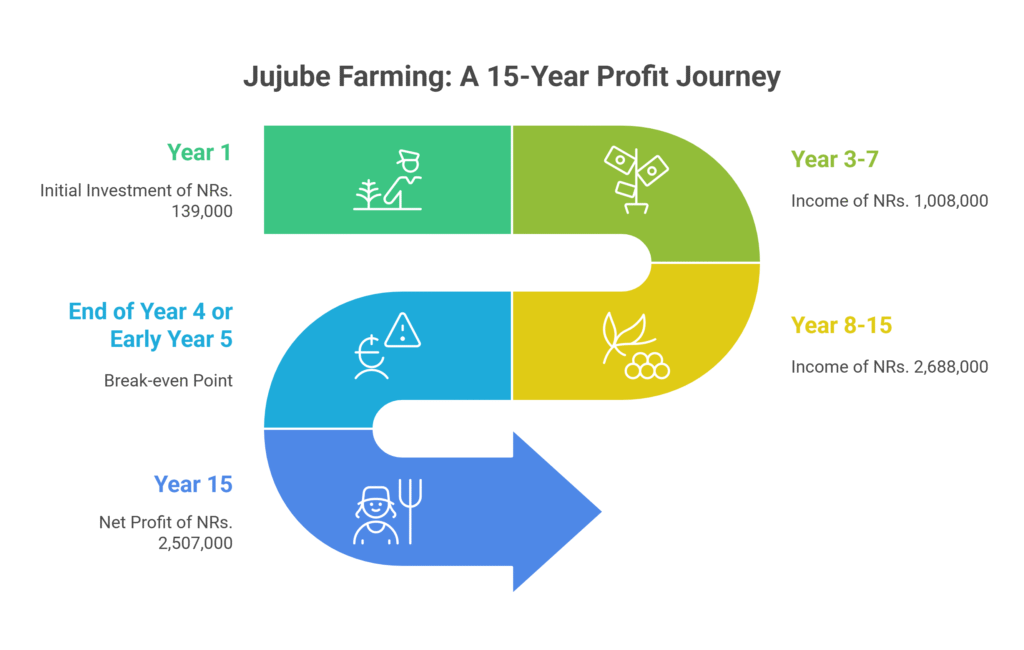
Over a 15-year period, Jujube farming yields a total income of NRs. 3,696,000 per acre—comprising NRs. 1,008,000 from Year 3 to 7 and NRs. 2,688,000 from Year 8 to 15 (at NRs. 336,000 annually).
The total cost incurred during this period amounts to NRs. 1,189,000, which includes an initial investment of NRs. 139,000 in Year 1 and annual maintenance costs of NRs. 75,000 from Year 2 to 15 (totaling NRs. 1,050,000).
This results in a net profit of NRs. 2,507,000 over 15 years. The break-even point is reached by the end of Year 4 or early in Year 5, when cumulative income surpasses the cumulative investment.
Sources
Food and Agriculture Organization (FAO)
Indian Council of Agricultural Research (ICAR)
Nepal Agricultural Research Council (NARC)
University of California Agriculture & Natural Resources (UC ANR)
Punjab Agricultural University (PAU)
Tamil Nadu Agriculture University (TNAU) – Agritech portal

